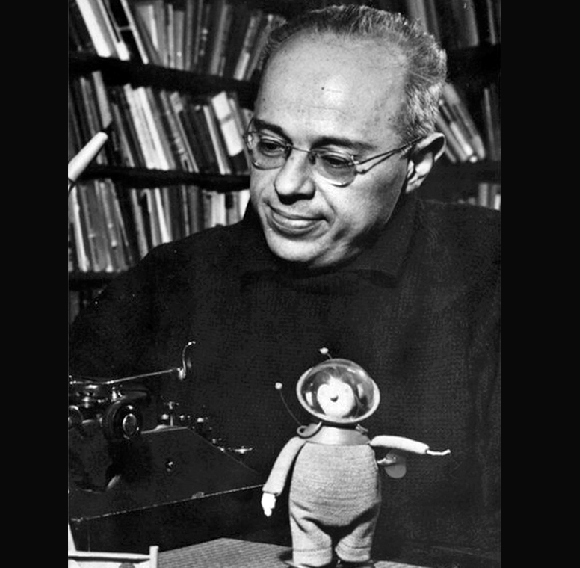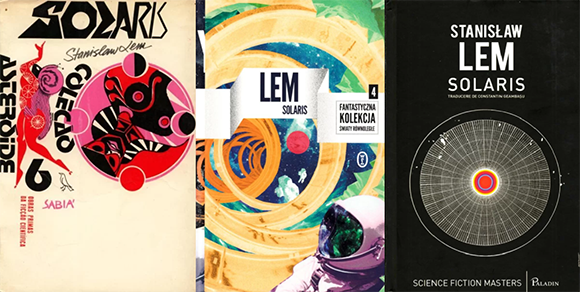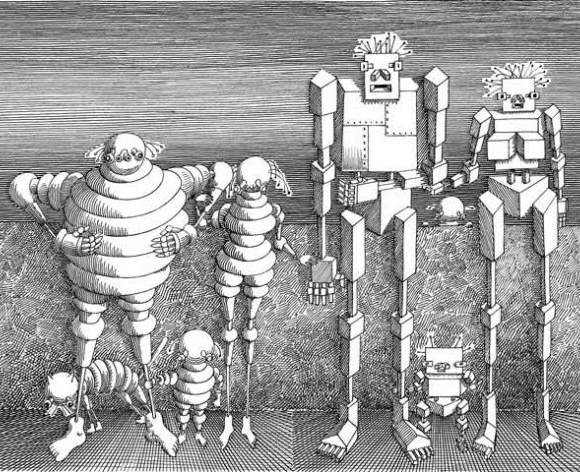Centenary of the birth of Stanislaw Lem, whose writing combined scientific concepts with social criticism, imagination, linguistic virtuosity and humour - in a manner no one else had done
Most crossword puzzle-solvers probably know that the obvious answer to the clue “A Polish writer” is “Lem”. Few will know his first name (Stanislaw) and even fewer will be able to tell that he was a writer of science fiction. Film enthusiasts among them will probably recognize him as the inspiration for ‘Solaris’ and ‘The Futurological Congress’” by Ari Folman, and some will add “Tarkovsky’s ‘Solaris’, not the Hollywood adaptation by Soderbergh”.
But Stanislaw Lem was much more than a clue to a crossword puzzle, and, in fact, he hated both films based on his book 'Solaris'. He was a writer and a futurologist, he engaged in philosophy of science and in literary criticism, studied medicine but never practiced it for a living. Even today, a hundred years since his birth and 16 years since his passing, he is considered the most worldwide famous Polish writer and a national hero in his homeland. His books have been translated into 45 languages, and Poland celebrates 2021 as the “Year of Lem”, including an official website and a variety of educational and cultural activities in his honor. Quite a feat for an assimilated Jewish boy from Lwów.

A variety of educational and cultural activities commemorating the great writer. The official logo of the “Year of Lem” in Poland | source: Adam Mickiewicz University
The Beginning of the Road
Lem was born on September 12, 1921 in the city of Lwów in Poland (now Lviv, Ukraine), the only son of Sabina and Samuel Lem, a laryngologist. World War II caught him at the beginning of his medical studies at the University of Lwów, which, until 1941, constituted part of the Soviet-occupied territories of Poland. In his biography he tells that he preferred to study science at the Lwów Polytechnic but was not accepted due to his “bourgeois origins”. “I started studying medicine - albeit half-heartedly”, he wrote.
In June 1941 the Germans occupied Lwów, and Lem was forced to discontinue his studies and conceal his jewish origins. He spent the following two years under a false identity, as a mechanic and a welder in a German raw material recycling company, and likely also assisted partisans who fought against the German occupation, although the level of his involvement in the underground activities remains unclear.
After the war, when Lwów came under Soviet control, Lem and his parents were forced to move to Krakow. Despite the tempting option to make a good living as a welder, Lem resumed his medical studies at the local university, at his father’s insistence. After finishing his studies in 1948, he refrained from taking his final exams in order to avoid being drafted to the army as a medical doctor. Instead he worked for two years as a research assistant at the Krakow Scientific Conservatory. He also published several papers on research methods and on the principles of scientific thinking. He eventually retired from academic pursuits after becoming fed up with the Soviet inclination towards Lysenkoism - a false pseudoscientific approach to genetics adopted by the authorities of all Esatern Bloc countries. In 1953 he married Barbara Leśniak, a medical student who later went on to become a radiologist.
While still a student, Lem published his debut work, the novella 'The Man from Mars', in a cheap commercial literary weekly newsletter. He later disowned the story, considering it an immature work. The publication of his first real book, the novel 'The Hospital of Transfiguration' (Szpital Przemienienia), which takes place in a psychiatric hospital during the Nazi occupation of Poland, was delayed due to communist censorship and was published only in the mid-50’s, after Lem had to add a few “idiologically correct” chapters.
A chance meeting in 1950 changed the course of his life. During a visit to the Polish Writers’ Union, Lem started a conversation with Jerzy Pański a publisher from the 'Czytelnik' publishing house, unaware of his affiliation, about the lack of original science fiction literature in Poland. Pański asked Lem whether he could write such a book and received an affirmative answer. “After a while, to my great surprise, I received an author’s agreement from 'Czytelnik'. Having no idea what the book will be about, I filled in the blank space with the word "Astronauts"... and in a quite short time I wrote my first book that was soon published”, Lem told. Thus began the literary career of one of the most original and influential science fiction writers of the 20th century.

Stanislaw Lem, a photo from 1966. courtesy of his secretary, Wojciech Zemek | Source: Wikipedia
A wordsmith
Lem’s literary writing relies on contrasts. His books combine grotesque humor with abysmal seriousness, optimism and love for humankind alongside pessimism and extensive occupation with man’s nothingness and pettiness. All of the above are accompanied by bursting creativity, deep philosophical contemplation and linguistic flare. All of these were manifested in one of his most important books: 'The Cyberiad' (1965), a series of short stories which was first translated to English in 1974.
At the very beginning, the secondary title of the book: 'Robot’s Tales', suggests an apparent contradiction. Continuing with this contrast all the way, Lem presents a series of wild tales taking place in a universe dominated entirely by robots. Humans are present in only a few stories, where they are referred to by the derogatory term “Paleface” and are regarded with contempt. And the robots? They are ostensibly the glory of technology, rational and thinking machines. Many of the stories include the recurring characters of the philosophers and inventors Trurl and Klapaucius. A pair of robots with supreme intelligence and infinite ingenuity. But like all other characters in the book, they are utterly ridiculous, from the last diode in their heads to their toes.
The robots in the book are ridiculous, since alongside their technological superiority, they are endowed with all of the faults and shortcomings of humans: greed, vanity, jealousy, aggressiveness and once again vanity, because it is never lacking. Lem abuses them mercilessly in order to create a poignant satire about humans, which would not have achieved its goals so beautifully, had it not gone so far as to use robots as characters.
The Cyberiad: Google’s interactive version, with original drawings by Daniel Mroz
The first story, 'The Three Electroknights' already illustrates well the satirical aspect. It tells the story of a great inventor who created the Cryonids - intelligent beings made of ice. These creatures have learned to create spectacular jewelry made of frozen crystals of rare elements, which attracted Electroknights who sought to rule sunless Cryonia. The first two failed, since their body heat melted a hole within the ice and they sank through it and were buried on the depths of the frozen ocean. The third Electroknight was initially successful in his mission, since he avoided thinking or feeling - actions that generate heat in its circuits, but he was eventually presented with a difficult puzzle that made him heat up and drown, just like his predecessors. “Since then no one has ever attempted to conquer Cryonia, since no such fools were left in the entire universe, although some say many of them still remain, they merely do not know the way to Cryonia”, Lem concluded.
This story, which is only four and a half pages long, has everything - satire and humor, social criticism, thought-provoking philosophical ideas, word games, plenty of imagination and even an understanding of scientific principles and their intelligent use. In other stories in “The Cyberiad” Lem creates a mechanized poet built to win a redundant competition between scholars, a robot that makes failed attempts at creating a happy creature, a machine that can create anything that starts with the letter N, a formula that promotes altruism ("Altruizine"), cybernetic dreams, a story within a story within a story and even a thermodynamic demon.
- The Cyberiad, Stanislaw Lem
The grotesque and satirical dimension is very prominent in many of Lem’s books. This is especially true for the books that deal with the character of the space tourist Ijon Tichy, the main character in 'The Star Diaries' and 'The Futurological Congress' as well as other stories and books. Much like Trurl and Klapaucius, Tichy is a combination of an almost omnipotent hero and a despicable and naive fool. This combination of talent and ridicule in the same person yields a great deal of humor and allows Lem to ridicule the prevailing common beliefs and institutions that Tichy encounters.
Humor and imagination are also manifested in his relatively late book 'A Perfect Vacuum' (1971), dedicated to scholarly critical reviews of books that never existed. The first book among them is, naturally, the fictional book 'A Perfect Vacuum' itself. Does it really exist? He went on to write more books with a similar concept. In the short story 'Layer Cake' (Przekladaniec), which was also adapted into a short film recently presented in the Jerusalem Film Festival, he presents a farce in which the ability to save people’s lives using organs taken from others raises severe identity issues. Such that the identity of the person who is a third of his brother, a quarter of his sister-in-law and so on, is utterly unclear, as is the question whether he should have any maternal responsibility towards the offspring of a woman whose organs were transplanted into him.

A sentient yet incomprehensible ocean | Image from the film “Solaris”, directed by Steven Soderbergh 2002
An ocean of misunderstanding
On the opposite pole of Lem’s work is his most famous book 'Solaris' - a highly contemplative, humorless and difficult to read, yet also fascinating, literary work. Lem’s virtuosity here is manifested not so much in the language or in deconstruction of literary structures but rather in the psychological richness and in the depth of his ideas, in line with the finest Central-European literary traditions within which his formation as a writer took place.
Solaris is the name of a planet, or more precisely, it is the name of the ocean that resides on its surface. While most science fiction literature dealing with interactions with aliens present them as some type of human-like entities, having insect consciousness or octopus tentacles at the most, in this book Lem created the most inhuman extraterrestrial intelligence that can be - an ocean that covers an entire world. It is, without doubt, a sentient entity, that even responds to the presence of the people who came to study it, but what basis for communication could there be between tiny carbon-based creatures and… an ocean?
The book’s protagonist is a psychologist sent to assist a small crew of human researchers in a space station that orbits Solaris. Through his eyes we see their futile attempts to communicate with the ocean and their handling of his reaction to their presence - ghostly entities created by the ocean from their own memories that now accompany them everywhere. Do these ghost entities represent an attempt by Solaris to communicate with the crew members, or are they simply the result of an unexplained action by the ocean? It is unclear. What is clear though is that humans are incapable of dealing with these figments of their own memories and will do anything in their power to destroy them.
- Solaris, Stanislaw Lem
The book was translated to Hebrew by Aharon Hauptman, a futurologist by profession and former editor of the science fiction magazine 'Fantasy 2000', after watching the movie adaptation by the renowned Russian director Andrei Tarkovsky, and upon reading the book, he felt compelled to publish it in Hebrew. “When I read the book, I understood what a travesty the film was to the literary work, whose linguistic richness and philosophical depth are untranslatable to the cinematic medium”, he wrote at the time. In a conversation with the Davidson Institute website this month Hauptman explained “I was fascinated by the description of the most extraordinary alien entity I have ever encountered and the issue of communication between it and the humans, but especially by the multiplicity of layers in the book: scientific, philosophical, psychological and theological”.
The inability to communicate with beings different than ourselves is a recurring theme in Lem’s works. The identity and characteristics of the foreign entities changed from book to book: a sentien ocean (Solaris), an alien society (Eden), a swarm of robots (The Invincible) and even other humans. Upon their return to Earth, the crew of the spaceship in 'Return From the Stars' discovers that human society has changed in their absence and is no longer interested in their achievements.

Lem himself despised the two films that were made based on his famous book. Different editions of “Solaris”
Alongside his creativity and the conceptual breadth of his ideas, Lem had a large and significant blind spot - he could hardly see nearly half of humankind - women - nor did he write about them. Like most science fiction authors of his time, his books and stories dealt mainly with smart, educated and adventurous men - mostly scientists and spaceship crews. Even most of his robots were male. Women, if they ever appeared, were mainly used as backdrop for the male characters or as a means to resonate their inner ongoing, as in Solaris.
What makes Lem unique is a combination of ‘crazy’ sci-fi ideas with an ironic and sarcastic look at humans” Hauptman concludes, “and naturally, the lingual pyrotechnics that are present even in ‘Solaris’, in marvelous descriptions of nature of the different and strange shapes created by the ocean, with strange and different names”.

Robots are human too | Illustration: Daniel Mroz. From the first edition of “The Cyberiad”
A nonconformist
Alongside his extensive literary work, Lem composed many essays and articles, mainly regarding futurology and writing. His solid opinions regarding the correct manner in which to write science fiction led him on a collision course with most of the global science fiction communities, following a controversial article he published in the 1970’s, entitled 'Science Fiction and Futurology'. In the article Lem sharply criticized both American and Russian science fiction, arguing, in a very crude generalization, that Western science fiction shames the potential stored in innovation and ingenuity, substituting it with cheap gimmicks and non-original tales, that use fancy technology as a backdrop instead of trying to understand it and its ramifications for humans: “It is the vulgar mythology of a technological society” he said. At the same time he also criticized Russian science fiction, which he described as being “banal''.
These claims, which were partially true but were based on very incomplete knowledge of Western science fiction literature, caused a great commotion. The Science Fiction & Fantasy Writers of America (SFWA) association, that presented Lem with an honorary membership in 1973, ousted him from the organization following an intense internal debate during which the association’s chairman, author Philip Jose Farmer, threatened to resign unless Lem was expelled from their ranks. The official reason given for his expulsion was that his books were published in English translation, and therefore Lem had to pay regular membership fees, but it was clear that the true motive were the insulted feelings. Lem himself refused to apply for a membership and stated, “I wrote the article not with the intent of publishing a harsh criticism… it is merely an expression of my personal utopia: a yearning for better science fiction literature”.
In 1982, when martial law was declared in Poland, Lem moved to Austria for several years, where he wrote his last two books of prose: 'Peace on Earth' and 'Fiasco'. He returned to his homeland in 1988, close to the collapse of the communist regime. In the 1990’s he focused on theoretical and publicist writing, mainly in the field of futurology. In an interview two years before his demise, Lem explained that he no longer writes fiction “because the world around us is dying out rapidly”.
Lem was highly esteemed during his lifetime. Thanks to his extensive knowledge in various fields and to his creative thinking he was invited to many international conferences, and was even the sole non-scientist to attend the first Soviet-American Conference on Communication with Extraterrestrial Intelligence (CETI) in 1971. On his visits to literary conferences in the Soviet Union and in Prague he was received with admiration, according to his accounts. He passed away on March 27th, 2006, leaving behind millions of fans and an extensive and complex body of work. Much more than just a clue in a crossword puzzle.
